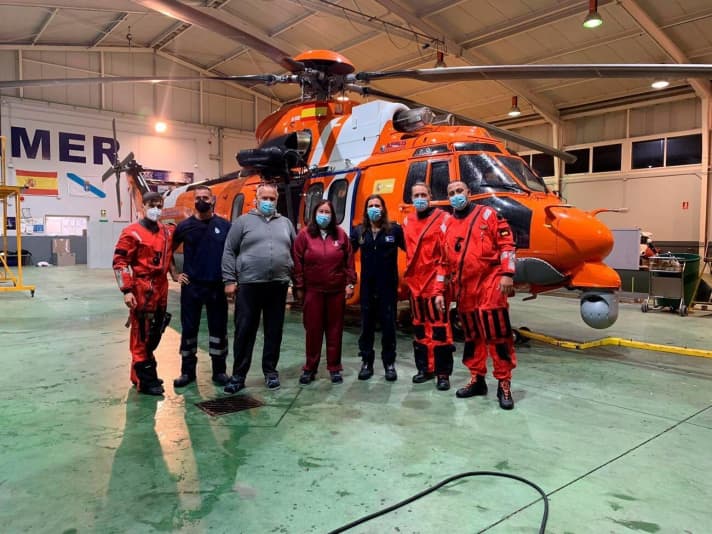
In mid-September, the German yacht "Milu", home port Düsseldorf, was abandoned a good 160 nautical miles north-west of A Coruña on the Spanish Atlantic coast. The crew - the owner, his partner and a fellow sailor - were rescued by a Spanish coastguard helicopter after they were supposed to jump into the water to be rescued. The sailors had been unable to stop the water from entering the 13.90 metre long steel Van de Stadt Norman 40 after a collision the night before.
Owner and skipper Michael Hunsdiek describes the events:
"On 14 September we, a crew of three, sailed from Portland/UK towards the Azores/São Miguel. The weather was good: rough wind with 3 to 4 Beaufort. The genoa and main were set, the main was secured by a bullstander as there were some wind shifts.
We headed towards the continental shelf for the transition to the deep water area. We monitored the weather with the Furuno weather fax, which is displayed directly on the plotter. We also used the Bonito analysis programme MeteoCom 6 with its own short-wave antenna. We also monitored the barograph, air and water temperature.
The wind picked up steadily on 16 September. The weather information showed us a strong storm depression near the Azores, which seemed to be intensifying into a hurricane, as well as two small, strong lows directly behind it. I decided to change course from 242 degrees, which would have taken us directly towards the storm depression, to 175 degrees to head for the northern Spanish city of A Coruña. We took away the genoa and reefed the main into the third reef. After that, the speed was still 6.5 knots.
The 'Milu' worked its way through the cross waves, it was a pitch-dark new moon night. There were one or two noises - they were muffled noises, possibly from a drifting container or something else that didn't fit in with the others. We immediately checked all the bilges, but they were dry. The automatic bilge pumps were set to green.
The pumps started up at 10 a.m. on 17 September. The check revealed water in the bilge. I went outside to operate both hand pumps as well. All the crew members were busy pumping water outside.
It was not possible to locate exactly where it came from. Only the rough direction: starboard amidships and starboard aft. We managed to lower the water level, but it didn't take long for it to start leaking heavily again. The first automatic pump also failed. It could not be restarted.
We installed a replacement pump, which worked the whole time. Despite all the pumps, the water kept increasing.
We were about 160 nautical miles from A Coruña.
We tried to contact ships to request technical assistance. On the Jotron TR 8000 commercial AIS, I saw the Danish tanker 'Nord Superior' ten nautical miles away. After successfully making contact, we asked him to contact the coastguard for technical assistance.
After a while we realised that, despite the pumps, we would still have about four hours if the water continued to enter the ship like this.
We now turned our request for technical assistance into a DSC distress call, which was then forwarded by the 'Nord Superior'. In the meantime, the tanker had turned round and headed for us.
If necessary, we could have reached the rescue control centre in Bremen via shortwave or activated the Epirb. An Iridium telephone and the life raft were also ready for use.
The coastguard sent a Helimar 402 because of the distance. At around 4 p.m., the tanker informed us that the helicopter would take around 70 minutes. He also told us that his lifeboat was ready to drop if the helicopter didn't make it in time to pick us up.
Finally, at 5.15 pm, the helicopter contacted us via channel 6. We stayed in contact with the tanker via channel 16. The helicopter crew instructed us to recover the sail and stop the engine as soon as it came into sight.
A short time later, the helicopter hovered over us. For us, this meant checking our lifejackets again and taking off our lifebelts. One by one, we jumped into the water and just over 15 minutes later we were all sitting in the helicopter.
The flight to A Coruña again took a good 70 minutes and involved flying around a thunderstorm cell.
After landing, we were very well looked after, had a hot shower and were given an emergency rucksack with everything we needed in it. Once we had dried off and changed, we thanked the rescue crew again. They told us that there are also whale attacks on yachts in the area and that they had already rescued the crew of three yachts three days before us."

After the rescue manoeuvre, shipping was warned about the drifting yacht, which has probably long since sunk.

